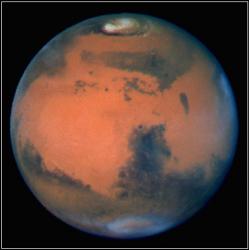If Mars ever had water flowing on its surface, as the many canyons and riverbed-like features on the Red Planet seem to indicate, it also would have needed a thicker atmosphere than what encircles that planet today. New research has revealed that Mars did indeed have a thick atmosphere for about 100 million years after the planet was formed. But the only thing flowing on Mars’ surface at that time was an ocean of molten rock.
A study of Martian meteorites found on Earth shows that Mars had a magma ocean for millions of years, which is surprisingly long, according to Qing-Zhu Yin, assistant professor of geology at the University of California- Davis. For such a persistent event, a thick atmosphere had to blanket Mars to allow the planet to cool slowly.
Meteorites called shergottites were studied to document volcanic activities on Mars between 470 million and 165 million years ago. These rocks were later thrown out of Mars’ gravity field by asteroid impacts and delivered to Earth — a free “sample return mission” as the scientists called it — accomplished by nature.
By precisely measuring the ratios of different isotopes of neodymium and samarium, the researchers could measure the age of the meteorites, and then use them to work out what the crust of Mars was like billions of years before that. Previous estimates for how long the surface remained molten ranged from thousands of years to several hundred million years.
The research was conducted by the Lunar and Planetary Institute, UC Davis and the Johnson Space Center.
Planets form by dust and rocks coming together to form planetisimals, and then these small planets collide together to form larger planets. The giant collisions in this final phase would release huge amounts of energy with nowhere to go except back into the new planet. The rock would turn to molten magma and heavy metals would sink to the core of the planet, releasing additional energy. The molten mantle eventually cools to form a solid crust on the surface.
Although Mars appears to no longer be volcanically active, NASA’s Mars Global Surveyor Spacecraft discovered that the Red Planet hasn’t completely cooled since its formation 4.5 billion years ago. Data from MGS in 2003 indicated that Mars’ core is made either of entirely liquid iron, or it has a solid iron center surrounded by molten iron.
Original News Source: UC Davis Press Release


I have three suspected martian meteorites but do not have verification on where they may have been found as the collectors are now dead. How could they be identified and what elements would be present to verify their origin? I would appreciate any help and look forward to hearing from you.